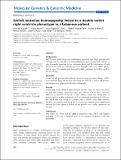GATA5 mutation homozygosity linked to a double outlet right ventricle phenotype in a Lebanese patient

View/
Author
Kassab, Kameel
Hariri, Hadla
Gharibeh, Lara
Zein, Manal
El‐Rassy, Inaam
Nemer, Mona
El‐Rassi, Issam
Bitar, Fadi
Nemer, Georges
Note: Order does not necessarily reflect citation order of authors.
Published Version
https://doi.org/10.1002/mgg3.190Metadata
Show full item recordCitation
Kassab, Kameel, Hadla Hariri, Lara Gharibeh, Akl C. Fahed, Manal Zein, Inaam El‐Rassy, Mona Nemer, Issam El‐Rassi, Fadi Bitar, and Georges Nemer. 2015. “GATA5 mutation homozygosity linked to a double outlet right ventricle phenotype in a Lebanese patient.” Molecular Genetics & Genomic Medicine 4 (2): 160-171. doi:10.1002/mgg3.190. http://dx.doi.org/10.1002/mgg3.190.Abstract
Abstract Background: GATA transcription factors are evolutionary conserved zinc finger proteins with multiple roles in cell differentiation/proliferation and organogenesis. GATA5 is only transiently expressed in the embryonic heart, and the inactivation of both Gata5 alleles results in a partially penetrant bicuspid aortic valve (BAV) phenotype in mice. We hypothesized that only biallelic mutations in GATA5 could be disease causing. Methods: A total of 185 patients with different forms of congenital heart disease (CHD) were screened along 150 healthy individuals for GATA4, 5, and 6. All patients' phenotypes were diagnosed with echocardiography. Results: Sequencing results revealed eight missense variants (three of which are novel) in cases with various conotruncal and septal defects. Out of these, two were inherited in recessive forms: the p.T67P variant, which was found both in patients and in healthy individuals, and the previously described p.Y142H variant which was only found in a patient with a double outlet right ventricle (DORV). We characterized the p.Y142H variant and showed that it significantly reduced the transcriptional activity of the protein over cardiac promoters by 30–40%. Conclusion: Our results do prove that p.Y142H is associated with DORV and suggests including GATA5 as a potential gene to be screened in patients with this phenotype.Other Sources
http://www.ncbi.nlm.nih.gov/pmc/articles/PMC4799877/pdf/Terms of Use
This article is made available under the terms and conditions applicable to Other Posted Material, as set forth at http://nrs.harvard.edu/urn-3:HUL.InstRepos:dash.current.terms-of-use#LAACitable link to this page
http://nrs.harvard.edu/urn-3:HUL.InstRepos:26860270
Collections
- HMS Scholarly Articles [17922]
- SPH Scholarly Articles [6362]
Contact administrator regarding this item (to report mistakes or request changes)


